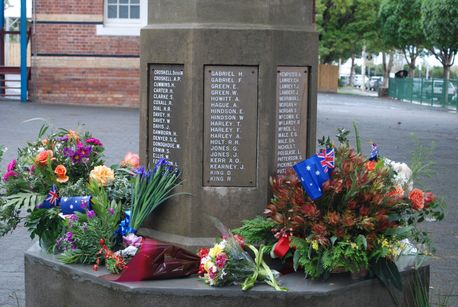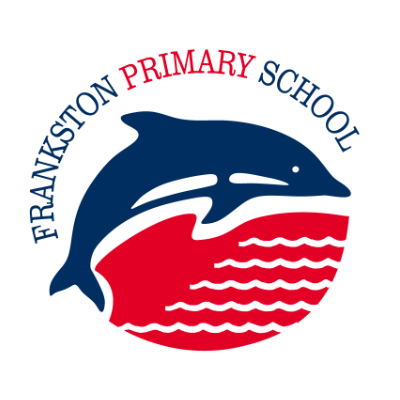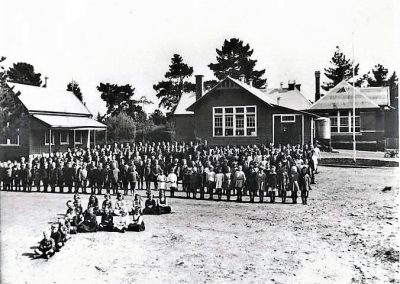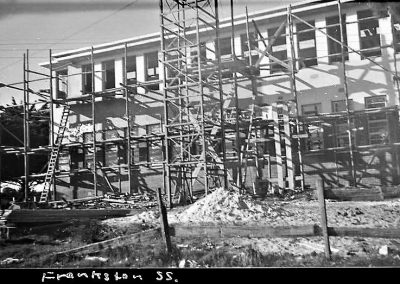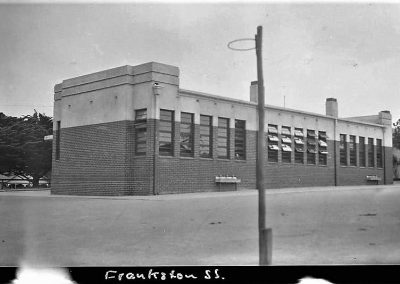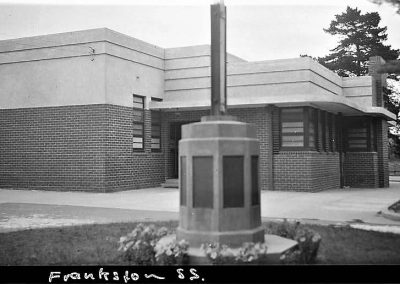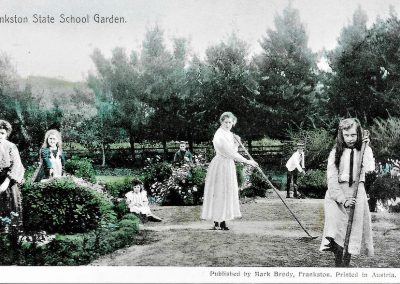History
This history of the Frankston Primary school was first compiled in 1968 by Mr. Roy W Brown who was the Principal of the school from 1968 to 1970. Much of the information relating to the early days has been obtained from Hunter Rogers, The Early History of the Mornington Peninsula and from Don Charlwood’s, History of Frankston.
All of the information relating to the school has come from the archives of the Education Department, the Latrobe Library, and from the school records. It is indeed fortunate that the school registers from 1874 onward are still intact; as it is from these that a wealth of personal detail has been derived. The school committee wishes to acknowledge the contribution made by Mr. Brown, although some minor changes have been made to his original text. Frank Purcel l October 1974


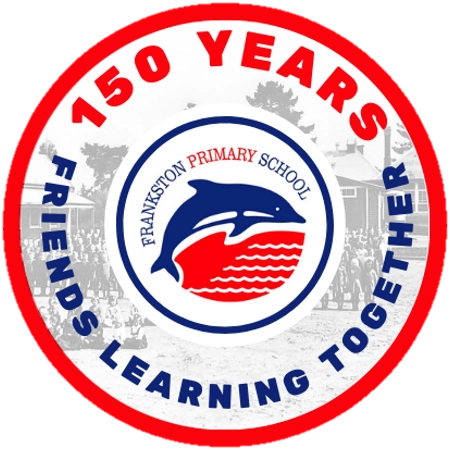
Honour Roll Of Head Teachers
1874 – 1877
Alexander Allan
1877 – 1878
John H Potts
1878 – 1881
Thomas D Keen
1881 – 1882
William H Bourke
1882 – 1892
Thomas S Robinson
1892 – 1895
Peter Dial
1895 – 1901
John Shiel
1901 – 1907
James O Hughes
1907 – 1917
William H Richardson
1917 – 1928
James D Jennings
1929 – 1933
Albert A Sublet
1933 – 1936
Norman G Carter
1936 – 1940
Harold Tate
1940 – 1942
Harold Hughes
1942 – 1949
John Williams
1949 – 1955
Lionel S Martin
1955 – 1960
Frederick W Aisbett
1961 – 1968
William A Shakespeare
1968 – 1970
Roy W Brown
1971 – 1972
W Baker (Acted As Principal)
1973 – 1980
Reginald F Ashdown
1980 – 1982
Audrey Carruthers
1982 – 1983
Jean Arney
1983 – 1985
Leon Hogan
1987 – 1990
Robert Rhymes
1991 – 1994
Doug Le Bas
1995 – 2004
Anne Marshall
2004 – 2005
Tatiana Shepherd
2005 – 2008
Jim Wilson
2008 – 2018
Morry Rubinstein
2018 –
Renee Kennedy
A Beginning
Following his sighting, Flinders sailed the Lady Nelson into the bay on 14 February 1802, after having returned from King Island. At the end of April 1802, Flinders entered the bay in the Investigator and came up as far as Mornington.
Early in 1803, Surveyor-General Charles Grimes made a detailed examination of Port Phillip and the same year saw the first attempt at colonization by a party led by David Collins. The failure of this venture saw the party move from the site at Sorrento to the Derwent River in Van Diemen’s Land. In 1834 with Van Diemen’s Land colonized, expeditions began crossing to the mainland and establishing settlements. The Henty’s settled at Portland, Batman and Fawkner at Melbourne.
Among the personalities prominent in pre-gold rush Melbourne was one Captain Baxter, the first Postmaster in the Colony, who had extensive land interests in the Port Phillip area. He is buried in the Frankston cemetery, but the name is perpetuated in Baxter Street.
The Liardet family who settled at Ballam Park was also notable in colonial affairs. The enormous influx of people into the colony following the discovery of gold spread people far and wide throughout the colony.
The first man to settle at Frankston proper appears to have been William Davey, who built a house overlooking Daveys Bay. The earliest settlers in the district made a living woodcutting. Later the villagers derived an income from fishing and cutting sheoak for the bakers’ ovens of Melbourne.
The First School
From the outset, the inhabitants of Frankston Village were anxious that their children received some kind of education. As at first there was no state system, the churches took the initiative and established schools where settlements were established. The first school in Frankston was opened in 1855, in a wooden building situated on land belonging to the Church of England near what later became the Frankston Park Oval. As far as can be gathered it was an undenominational school. The first Head Teacher was a Miss Deane, who later became Mrs. Burrell. Some of her pupils were children of the McComb, Wells, Carr, MacMahon, Liardet and Kelly families. The youngsters paid a shilling per week for tuition. When Victoria became a separate colony in 1851, existing schools were registered.
The Frankston Church School became Registered School No. 254. Education Department Records show that the school first received state aid on 1 October 1858, at which time a Mr. Edward G Savage was Head Teacher. Mr. Savage continued as Head Teacher until 1872. It is not known who followed Mr. Savage as Head Teacher, but the last Head Teacher prior to the school being struck off the roll on 31 October 1874 was a Mr. Alexander Allan, who became the Head Teacher of the first State School which opened on 1 November 1874. Although struck off the Roll of Registered Schools, this original school probably continued as a private school.
The First State School
In 1851 Victoria was established as a separate colony. In the year 1872, an Act of Parliament established the Education Department of Victoria as the statutory body controlling education in this state. As State Schools were established, either in new or in existing buildings, most of the children already attending school transferred to them. This is, in fact, what happened at Frankston. It appears that before a State School could be built in a particular area, parents had to petition the Government for its establishment. A well-known citizen of Frankston, Mrs. Grace McComb, trudged the sandhills from home to home to obtain the necessary twenty signatures on the petition. It is interesting to note that at the time of the compilation of this history (1968), descendants of Mrs. McComb still resided in Frankston. On receipt of the petition, the Education Department took immediate action. The school site, with a frontage of 132 yards to Davey Street and of 110 yards to Baxter Street was gazetted on 21 November 1873, and the school building was completed in October 1874.
The school, Frankston 1464, opened on 1 November 1874. The first Head Teacher was Mr. Alexander Allan, who had as his work-mistress, Augusta S Petrie. Mr. Allan continued as Head Teacher until 30 June 1877. The school consisted of one room large enough to accommodate 60 pupils and had a three-roomed residence attached for the use of the Head Teacher. Both school and residence were built of timber. Departmental records show that in the financial year 1874-75 the sum of £385.11.9 was spent on schoolhouse and furniture.
The school opened with an enrolment of 45 pupils, and a further 6 pupils enrolled on 1 December 1874, bringing the total to 51. The average attendance was, however, only 30. Was it lack of interest or difficulty in getting to school which accounted for the comparatively low average attendance? One wonders.

The First Pupils
The original school register is still in the possession of the school and shows that the following pupils attended on the first day:
Grade 5 – Inwood Oliver, David Petrie, Edwine Oliver, Theodore Savage, Erskine Petrie, Agnes Mccomb, Rose RichieGrade 4 – Henry Landher, John Corlett, Janet Richie
Grade 3 – Frances Wright, Silas Oliver, Richard Wells, John Bentick, Martha Mccomb, Emily Petrie, Mary Richie, Mabelle Savage, Mary Ann Mouldy
Grade 2 – Harriet Mouldy, Ellen Corlett, Jane Deane, Mary Renouf, John Box, Albert Bentick, Charles Bentick, George Williams
Grade 1 – Thomas Richie, Ernest Mccomb, Joseph Deane, Hannah Durley, Charlotte Deane
Other children who attended on the first day but whose grade is not specified:
William Jones, Susan Williams, Ellen Jones, Sarah Jones, Joanna Jones, Euphemia Savage, Anne Box, Hannah Milliard, Mary Williams, Amy Davey, Henry Wells, Elizabeth Hastings, And Hannah Landher
Pupils who were admitted to the school on 1 December 1874:
William Mouldy (Grade 1) Decimus Wells (Grade 4), Jacob Mouldy, Thomas Peirara, Isabella Davey, William Deane (All In Unspecified Grades)
The Early Years
In 1854, Mr. James B Philip carried out the first survey of Frankston Village and drew up a plan showing approved sub-division. There were ten blocks in the area bounded by Davey Street, Wedge Street (now Young Street), Park Street, and Baxter Street. Blocks 5, 6, 7, 8, 9 and 10 were gazetted in 1873 as the site for Frankston State School No. 1464.
Originally the school was enclosed by a post and rail fence and was surrounded by trees and scrub. Later a picket fence was erected along the Davey Street frontage. The school ground itself was flat on the side nearest Davey Street and the school was built on this level area. From approximately halfway back towards Park Street the ground sloped fairly steeply down but leveled back out again approaching the fence. Probably, less than half of the school ground was even reasonably level. Davey Street (Hastings Road) was a made road, but Baxter Street, Wedge Street and Park Street were mere scrub-lined sand tracks.
Where Beauty Park is now situated there was an extensive spring-fed swamp with an island in the middle of it. A tiny creek carried surplus water, particularly in the winter, to Kananook Creek. Later the swamp was drained, filled with soil and Beauty Park established.
Originally, in the centre of this Park, a quite extensive aviary and a miniature zoo were prominent features. Unfortunately, winter floods created such havoc with birds and animals that both aviary and zoo were abandoned.
From the very earliest days, many children rode to school on ponies as they came quite long distances. The ponies were tethered to rings along the fence nearest to Wedge Street. In the early days of the school, probably between 1874 and 1890, two rows of pine trees were planted right around and inside the school boundary fence. At the time of the compilation of this history (1968), four of these are still standing. They are magnificent specimens. Between 1917 and 1928, the Head Teacher, Mr. J D Jennings planted rows of cypress trees along the Davey Street and Baxter Street frontages. These were first trimmed into hedges but were later left untrimmed and allowed to grow at will. These trees are still standing, and because of their grandeur, give the school a character that is quite unique. Mr. Jennings also planted ornamental trees of various kinds across the school ground near the crest of the sloping area. Apart from their aesthetic value, these trees provided an effective screen between the toilets and the school. A fine and extensive garden along the line of the ornamental trees enhanced the general attractiveness of the school grounds. It is no small wonder that the school won the ANA Prize for the most improved school ground in the Inspectorate in 1927.
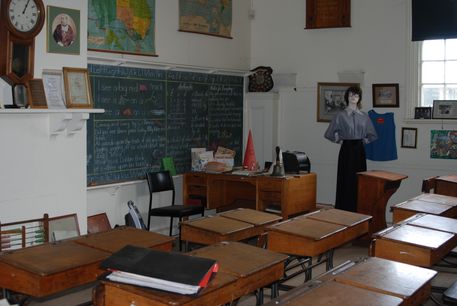
Accommodation problems beset the school from time to time and perhaps the earliest evidence is the following letter the Secretary of Education wrote in the late 1890s.
“To the Honorable C H Pearson Minister of Education Education Department, Melbourne Sir, We the undersigned parents of children attending the Frankston State School, No. 1464 beg respectfully but firmly to protest against the delay in proceeding with the erection of a Brick School to replace the present unsuitable building.
As has already been pointed out to you by Parents, Board of Advice, Municipal Council and Parliamentary Representative, the present Building is in every way unfit for occupation by the large number of children that could attend in Frankston and there is abundant evidence of the feeling of the Parents on this point, in the fact that the attendance is decreasing while the population is increasing.
We had expected, according to promise made to Deputation about 3 months ago, that the brick front of a new building would be proceeded with, together with improvements to present old building – We did not advocate this latter work, as we do believe that money spent on the old building will be wasted, but we certainly expected a commencement would be made with a new structure. Under these circumstances we have first ground for complaint that the only addition made has been the taking in of the dwelling home to add to the accommodation and when we find that this dwelling is infested with vermin and that in spite of the burning of sulphur they are still in the crevices of the old linings and have been carried home on the children’s clothing we object any longer to allow this state of things to exist.
Other places in this district have far better and more substantial School Buildings and here in Frankston where private enterprise is doing so much for the advancement of the place, we have absolutely no Government money expended and have to put up with the annoyances above referred to. We therefore ask that a permanent Brick Structure be at once erected and the attendance which is now dwindling will undoubtedly prove the reasonableness of this demand. We are Sir, Your obedient servants, John Cameron, Samuel Sherlock, Thomas Davey, Annie Renouf, George Bentick, John Dixon Box, W. Laurey (sic), Robt. Patterson, Emmy Croskell, James Millard, Frederick Addicott, Ezekiel Coxall, (and others)”.
Although the net enrolment steadily increased from 1874 onwards, no additional accommodation was necessary during the tenure neither of Mr. Allan (1874-1877) nor in the time of his successor, Mr. John H Potts (1877-1878). However, in 1880 whilst Mr. Thomas D Kneen (1878-1881) was Head Teacher, the original classroom was extended to accommodate 100 pupils and a fourth room was added to the school residence. Again there were no additions in the time of Mr. William H Bourke (1881-1882). Mr. Thomas S Robinson was Head Teacher from 1882 to 1892. By this time the school had become a Class 4 school with a net enrolment of approximately 250. As a result, by the middle of 1889, the residence had been converted to a classroom measuring 28 ft by 25 ft and the brick classroom sought by the petitioners to the Minister and measuring 30 ft by
20 ft had been added. Probably an office was provided at the same time, the corridor providing access to it separating the new brick classroom was constructed of timber. At any rate there was accommodation for the number of pupils then in attendance.
The Head Teachers following Mr. Robinson were Mr. Peter Dial (1892-1895), Mr. John Shiel (1895-1901), Mr. John O Hughes (1901-1907), Mr. William W Richardson (1907-1917) and Mr. James D Jennings (1917-1928). Between 1913 and 1924 there were extensive alterations, but the exact date or dates of these cannot be ascertained. A partition had been erected across the original timber classroom, dividing it into two classrooms measuring 26 ft by 18 ft and 24 ft by 18 ft respectively. Three new timber classrooms, separated from the earlier buildings by a corridor and each measuring 26 ft by 24 ft had been constructed, and the 28 ft by 25 ft classroom made in 1889 by remodeling the school residence was moved some distance away from the main school to provide a sloyd centre. It remained as such until 1939 when it was pulled down and the timber used to construct a shelter shed near the school fence fronting Park Street.

We do know that the Frankston State School contributed a substantial sum of £706.5.7 to the 1914-18 War Relief Fund. We also know the names of ex-students and teachers of the school who fought or otherwise served in that war. They are inscribed on bronze plates surrounding the base of the War Memorial in front of the school. This memorial was designed by Mr. Ward, an architect, and the concrete work was carried out by Mr. T D Barrett. It was unveiled late in 1924 or early 1925. The names recorded on this memorial appear as an appendix to this History. School records (early School Committee Minute Books) show that electricity was connected to the school in 1926.
From the same source, we learn that a porch was erected at the front gate though we do not know why. We learn too, that in May 1922, moves were being made to press for the establishment of a High School in Frankston. These moves bore fruit, for the Frankston High School opened at the beginning of 1924. An interesting sidelight of this was that when the 7th and 8th grades were transferred to the new High School there were loud protests from some parents who did not want their children to receive the type of education it provided. Was it that they needed their children for work on the farm, the orchard or in some industry they were engaged in, as soon as they became fourteen years of age or was it simply that many could not afford the fees?
In the School Committee minutes of 1922, mention is made of the Frankston Boys’ Home. In those of May 1928, mention is made of the Minton Boys’ Home. It would appear that these two schools were one and the same and authentic information is that the school was still later known as the Menzies Boys’ Home School. This school closed at the end of 1961 and the 37 boys enrolled there were transferred to Frankston State School No. 1464 at the beginning of the 1962 school year. From 1922 onwards, the task of compiling the History of Frankston State School although still onerous is somewhat easier because School Committee Minute Books are available. These contain valuable and authentic details, and what follows is taken mainly from them. Inspectors’ Report Books from 1941 onwards are also available, and information relating to the years from 1941 has been gleaned from both the above sources.

Consolidation And Expansion
Little is known of the history of the School Committee before 1922. The earliest information available at the time of writing is that in 1922, the School Committee consisted of the following members:- Chairman: Dr. Maxwell Correspondent: Mr. H B Legge Treasurer: Mr. W M Hanton Other members: Mr. L J Ward Mr. F H Wells Mr. W C Young Captain Cookson Mr. J Jolly. From its establishment in the 1830s, Frankston Village, as it was first known, has always grown steadily in both size and population. Perhaps the word steadily is not quite appropriate, as sometimes the growth has been rather explosive. It is natural that the remarks made with reference to Frankston apply with equal force to Frankston State School. The school could not always accommodate the required number of pupils. Thus, the Masonic Hall supper room was leased in 1923 to accommodate a class. This was just prior to the erection of three timber classrooms to which reference has been already made.
In the 1922 minutes, reference is made to the purchase of timber for a pergola. This was erected at the front gate and when covered with creepers, as it was later, must have been quite an attractive enhancement to the entrance. In 1928, mention is made of the installation of the telephone at the school. For some reason or another, it was disconnected on 30 June 1933 and was not evidently reconnected until 10 February 1944. What story lies behind these facts?

The 1928 minutes record that the rainwater tanks were cleaned out. Evidently there was no reticulation system by then, or was it that there was such a system and that the rainwater was preferable for drinking? As has been mentioned previously, Mr. J D Jennings was Head Teacher from 1917 to 1928. He was a great tree and plant lover and the school today owes much to him. He was the first Class 3 Head Teacher and was succeeded by Mr. Albert A Sublet (1929-1933). Mr. Sublet was a Class 2 Head Teacher.
The average attendance had jumped from 250 in 1925 to 350 in 1932. Figures for the net enrolment are not available for either year, but they would have been much higher than those given as the average attendance. On 19 October 1928, the whole school went on a picnic to the Melbourne Zoo. A special train was hired for £25 and the school received a rebate of ten percent. The venture must have been a great success, for on 18 October 1929, schools throughout the entire Mornington Peninsula combined in what must have been truly a Monster Zoo Picnic. It can be taken for granted that this excursion was organised in the first place by the Frankston State School. Schools participating were:- Frankston, Frankston High School, Baxter, Somerville, Tyabb, Tyabb West, Moorooduc, Mt Eliza, Mornington, Carrum Downs, Seaford, Bittern and Crib Point.
In 1931, 20 dual desks were provided for use in the Infant Room to replace the old fashioned ones. Were the latter the real old-timers, with space for about seven children who sat on a lengthy wooden seat without a back rest of any kind? In 1933 the School Committee became interested in septic tank sewerage, and some members were delegated to inspect some of these in operation at other schools. The inspections were evidently convincing, and as a result, the Committee applied to the Education Department for the installation of such a system at Frankston. A septic tank sewerage system was in fact installed at the school in all probability in 1935 and was still in operation in 1968. In that year, however, word was received from the Education Department that it was intended to connect the school to the town sewerage system at an early date. Mr. Norman G Carter succeeded Mr. Sublet. He was Head Teacher from 1933 to 1936.
During his stewardship, the School Committee was again exerting pressure for additional accommodation. In 1937 the Health officer condemned the school as unhealthy and inadequate. There was no immediate response to the pressures exerted, but in 1938 the Education Department really came to the party, erecting three new brick classrooms, together with a new office and two rather small staffrooms at some distance from the original section which had served the community for so long. The condemned section was not however pulled down, but still served as an Infant Room block up to the time of writing (1968). The new brick section was to be the nucleus of the future school. In 1937, a shelter shed was built. This was the timber structure adjacent to the north-western fence, later used as the Infant Room shelter-shed.
Evidently, swimming was a school subject, for in 1937 the Foreshore Committee agreed to erect a dressing shed for the exclusive use of the Frankston State School children provided that the School Committee provided the sum of £25 towards the cost. Reference is also made in the 1933 minutes to the closing in on the Grade 6 veranda. This must have been a veranda at the northwest corner of the timber section of the school.
The Mothers Club according to all reports was functioning long before 1933, but the first reference to this body occurs in the minutes of 14 June 1933 when Mesdames McComb, Sherlock, and Kerr attended a School Committee meeting as representatives of the Mothers Club. The Office-bearers of the Mothers Club in 1935 were: President: Mrs. McComb Secretary: Mrs. Wells Assistant-Secretary: Mrs. Sherlock Treasurer: Mrs. Fazio.
Mr. Harold Tate was Head Teacher of Frankston State School from 1936 to 1940. He was evidently very interested in the physical welfare of the pupils, for in his term a First Aid Cabinet was purchased and a lounge provided for the comfort of children who became ill. Mr. Tate was succeeded by Mr. Harold Hughes (1940-1942). By 12 September the net enrolment had increased to 574 so that the school was once again overcrowded. Red flags were purchased, evidently for a School Crossing opposite the school in Davey Street, and Major General Grimwade donated two bugles to the school.
In February 1941, the bicycle shed and a tool shed were erected. Accommodation was so strained that a hall was rented to relieve pressure and classes were being conducted in the shelter shed. However, late in 1941, another brick classroom (Room 10) was nearing completion and was probably occupied towards the end of the year. 1939-1945 were, of course, the years spanning the Second World War, and that this was so, was reflected in school activities in many ways. Room 8 was at this time being used during the evenings as the headquarters of those in charge of Air Raid Precautions. Slit trenches were dug in the school ground and the children instructed in their use.


The school was busily raising money for the War Relief Fund, £600 being raised for the eighteen months ending 11 December 1941. In 1942 the school became a Class 1 school with Mr. John Williams as Head Teacher. Again, accommodation problems loomed largely. There were 67 pupils in Grade 6 and a composite 5th and 6th class used the Scouts Hall. A new Arithmetic Course was introduced and the Social Service League established. This superseded the Junior Red Cross Branch which up to that time had functioned to assist in relieving suffering or want.
The entry of Japan into the war and the shelling of Sydney from Japanese midget submarines resulted in plans being made for the evacuation of children to the country but fortunately these plans did not have to be put into effect.
Arbor Day was held at the School Plantation. Trees had evidently been planted there some years before this date. The plantation was sold through the Council in 1948 and the School received £57.3.7 as a result.
In 1943, in addition to the Scouts Hall to which reference has been made above, classes were being accommodated in two small and unsuitable rooms at the school. The Masonic Hall supper room was again rented. A deputation to the Minister of Education was arranged, and as a result, six new classrooms were promised. These were erected by W H Langdon & Son at a cost of £10,420 and form the Baxter Street wing of the school. Three of the rooms are on the ground floor, and the other three directly above. They were probably occupied late in 1945 or early 1946. Frankston High School was evidently having its problems too, for in 1945 it could not take all Grade 6 pupils seeking admission. Pressure was being exerted in 1944 for the erection of a Technical School or alternatively for a Technical School wing at the High School.
New developments in education are reflected in the equipment the school was acquiring during these years. A Miss McClelland donated a Wireless set to the school in 1944. In 1946 a second such set was purchased for £70 as well as an electric clock and a film strip projector. In May 1947, the school purchased a Sound system unit together with the necessary loudspeakers for use in the classrooms at a cost to the school of £205. It is rather amusing now to record that whilst much of this equipment was being acquired, the school was without electricity for twelve months. At the time, it must have been frustrating to the last degree. On 18 June 1948, a plaque attached to the wall in the main corridor of the school, commemorating former pupils who served in World War II, was unveiled by Dr Akeroyd.
It was in 1947 that the park rail fence was erected along the Davey Street, Baxter Street, and Park Street frontages, and the partition between two classrooms demolished to make an Infant Room assembly hall. An Opportunity Grade was established in the school in 1947. One wonders at the timing of this step, for by 1948 there were 700 children attending the school and eleven of the classrooms each accommodated over 50 pupils.
Mr. Lionel S Martin succeeded Mr. Williams in 1949 and remained as Head Teacher until 1955. It was he who had the garden behind the school terraced. The school ground was regraded also in his time. Mr. Martin must have had a most frustrating tenure of office. In 1950 the net enrolment was 762 but by 1951 it exceeded the 900 mark. The District Inspector, Mr. J D Davidson, wrote in his report that the school is excessively overcrowded. Even this is an understatement. There were four classes of over 70 pupils.
Two events took place in 1949 which are deserving of mention. Firstly the Council Library for district children was opened, and secondly, an epidemic of poliomyelitis swept Victoria. This scourge affected attendances at Frankston State School as it did those of most other schools throughout the state.

In 1950, the six classrooms added earlier were at last warmed by the central heating unit serving the rest of the school, and the school Junior Safety Council policed the school crossing. The toilet block had been extended and steel window bars and door plating had been installed to protect the school Office from burglary. 1951 saw the school win the ANA Prize for the second time for the most improved school grounds in the Inspectorate. (This prize was previously won by the school in 1927). Also in 1951, inter-school sport is mentioned and reference is made to the fact that a visiting projectionist attended the school regularly to screen educational films. A Schiedmeyer piano was purchased in that year, and a hot water unit was installed in the staffroom.
New Primary Schools Established
Prior to 1951, the policy of the Education Department in endeavoring to cope with the rapidly increasing number of primary school children in the Frankston area was to hire halls or to build additional classrooms at Frankston 1464, even though this meant that some of these children had to travel quite long distances. Somewhat belatedly, this policy was then changed, and new schools began to appear. The first of these was Frankston East which opened in February 1952, taking 200 children from Frankston and thereby reducing the net enrolment from 908 to approximately 700. Frankston East had more than its share of teething troubles as external conditions were deplorable. There was no shelter shed and there were toilet problems also. The school was overcrowded from the outset, so much so that the admission of beginners was restricted to those who became six years of age on or before 30 June 1952. A public meeting was held at Frankston East on 8 September 1952 to discuss the educational problems of the Mornington Peninsula. The meeting appointed a sub-committee authorized to make recommendations regarding the provision of technical education in the area, the establishment of additional High Schools on the Peninsula and also the establishment of a Consolidated School in the Tyabb or Boneo Road area. By 1956, the net enrolment at Frankston 1464 had again topped the 900 mark and again a class was accommodated in the Masonic Hall supper room. However, in February 1957, the Overport School built off Towerhill Road opened its doors and approximately 180 pupils transferred there from Frankston. The opening of the Kananook School near the corner of Wells Road and Boonong Avenue in 1958 relieved the Davey Street school of a further 42 pupils.
As far as educational developments in the area are concerned, the highlight of 1958 was the opening of the Frankston Technical School on 4 February of that year. The opening of the Technical School fulfilled a long-felt need in the educational field, one which had been discussed for at least twenty years. Pupils of the Frankston High School had in the meantime been accommodated in new quarters on extensive grounds on Towerhill Road. Frankston Heights State School, which opened in February 1962 took a further 45 pupils from Frankston 1464.
Other new primary schools were established in the area, Frankston Forest (August 1961), Fairway (June 1964), Monterey (August 1965) and Karingal (February 1966), took few if any pupils away from Frankston State. Whilst the rush of new primary schools was spreading in the vicinity of Frankston, domestic affairs continued much as usual at the mother school. Migrants were also settling in Frankston in increasing numbers, so much so that English classes for adult migrants were commenced at Frankston 1464 in 1951.
In 1952 there was quite a furor over the sale of intoxicating liquor in the school grounds, in connection with a statewide Fire Brigade Demonstration held at Beauty Park on 26 and 27 January of that year. The School Committee received letters from the Independent Order of Rechabites, from the Frankston Ministers Fraternal and from the State School Committees Association condemning its action in granting permission for such sale. The School Committee had in fact only granted permission after contacting the Education Department and that instrumentality had waived its stringent regulations in view of the importance of the function being held. The matter ended with a letter being written by the Committee to the Education Department expressing the view that in the future, on no account whatsoever, should the appropriate regulations be waived.
In 1952 a second piano was purchased. In 1954 the asphalted area was expanded and the pressure was being exerted on the Education Department for the erection of larger shelter sheds to accommodate the growing school population during either hot or inclement weather. At least positive action resulted in regard to the last item, for the firm of R F Hosie completed the building of a new shelter shed probably late in 1953 for the sum of £1229.15.0. 1953 was an eventful year for Miss Dorothy Richardson, an Infant Room teacher on the staff of Frankston 1464, in that she was awarded the Lilian Horner Prize, a prize awarded to the Infant Teacher conducting the most efficient Infant Room class throughout the state of Victoria. It is interesting to note that Miss Richardson was the daughter of the late Mr. William W Richardson who held the position of Head Teacher at the school from 1907 to 1917. Miss Richardson later returned to the school in 1964 as an Infant Mistress, Special Class. The presentation to Miss Richardson took place on 19 February 1954.
Also in 1954, the Frankston State School children, together with approximately 5000 other children from schools throughout the entire Mornington Peninsula were taken by train to Flinders Naval Depot to see the Duke of Edinburgh. This was a mammoth task in organisation and control. The Staff of Frankston 1464 was largely responsible for this organisation.
A fire occurred in the old school building in April 1954 causing damage to the extent of £100. This was of course in the days when those rooms were heated by wood fires and it was one of these that caused the outbreak. The Infant Room sandpits were established in 1954 and certain playground equipment erected in the same area. Over a thousand square feet of asphalting was completed above the terraced garden. Mr. Frederick W Aisbett came to the school as a Class 1 Head Teacher in 1955. The school was raised in status to a Special Class School in March 1956, and Mr. Aisbett evidently received a promotion to the Special Class at or about the same time. At any rate, he retained his position as Head Teacher at the school. The net enrolment of 909 in 1956 dropped to 725 in 1957 when 230 pupils were transferred to the newly opened Frankston South (now Overport) School.
In 1957 additional playground equipment was erected in the Infant Room playground area and electric lighting and power provided for the classrooms comprising the Baxter Street wing of the school. In 1958 the school was renovated and repainted, a 1000 watt film strip projector was purchased, additional outdoor seating was provided, the bicycle racks were repaired and extended and 42 pupils were transferred to the new Kananook School built at the corner of Wells Road and Boonong Avenue. An assistant from Frankston 1464, Mr. Roy Harvey, was appointed Acting Head Teacher at the new school pending a permanent appointment. The highlight of 1959 was the opening of the Frankston Teachers College. Frankston State School was immediately proclaimed a Training School and at once, members of the staff were engaged in the responsible work of training some of the future teachers of the state. Mention is made too in the Inspector’s Report for that year of migrant children. No doubt there were migrant children attending the school for many years before 1959, but evidently, by that date, the migrant percentage in the school was thought worthy of special mention.
In 1959 pressure was again exerted on the Department for further accommodation. It was effective, for two classrooms in light timber construction were erected in 1960. For the Education Department, this was quick action indeed! Mr. Aisbett retired at the end of 1960 and was succeeded by Mr. William A Shakespeare at the beginning of 1961. In that year a new record player was purchased and an SRA Reading Laboratory procured, the first to be used in the school. Frankston Heights State School opened in February 1962, and 49 pupils from Frankston 1464 transferred there. The loss in the net enrolment was compensated for by the transfer of 37 pupils to Frankston State School from the Menzies Boys Home School which was closed at the end of 1961.
Another important event in 1962 was the establishment of a Rural Training School within the Davey Street School. In the same year, the asphalted areas in the school ground were re-surfaced and black-out curtains provided in Room 7 to make the screening of educational films more effective. In 1963 a new septic tank was installed and the boy’s toilet remodeled. Some dangerous trees were removed and a concrete retaining wall built on the Park Street side of the Infant Room play area. Fluorescent lighting was provided in Rooms 11, 12 and 13 and the ladies staffroom renovated after being damaged by a fire started by vandals who had broken into the school. The Public Address system had been replaced by a more modern unit and new classroom loudspeakers provided. In 1964 the school crossing was re-sited and attention was given to the bus terminal. A versatile tape-recorder was also procured.
In 1965 the net enrolment which stood at 623 dropped to 573. School improvements included the conversion of the central heating unit from coke burning to an oil firing unit, the provision of low-level cisterns in the girl’s toilet, the covering of open areas in both toilets with wire mesh and the provision of cyclone gates for both toilets. New equipment purchased included a loud hailer.
A card system was introduced to facilitate reference to the progress of individual children. Mr. R J Chapman replaced Mr. M Crosthwaite (who had retired as District Inspector) in 1966. The net enrolment had surged to 671. The timber buildings were repainted and a new ladies toilet was provided in the Infant Room section. Two television receivers were acquired and the sound system extended to Rooms 17 and 18. The title of heads of primary schools was changed in 1967 from Head Teacher to Head Master. Mr. W A Shakespeare, therefore, had the honor of becoming the first Head Master of the Frankston State School. In 1967 a portable classroom was provided to relieve the pressure of numbers, some new play equipment was provided for the Infant Room and a Co-operative Society was formed to finance the building of a Central Library. Mr. William A Shakespeare retired in April 1969 and was succeeded as Head Master on 5 April by Mr. Roy W Brown.
Equipment to the value of $300 including two new record players was provided by the Mothers Club and library books to the value of $560 were provided by the School Committee. The boundary fence was re-wired, heat and lighting were provided in the annex being used as a classroom in the Infant Room block and a second portable classroom provided to cope with the net enrolment which by September had passed the 720 mark.

The years 1968-69 were notable because of the formation of the Frankston State School Co-operative Society, to finance the building of a Central Library, and also because of the actual erection of the Central Library. The chairman of the Co-operative Society was Mr. Brian Jackson and the Secretary-Treasurer was Mr. John Vanselow. The firm of D B Tincknell Pty Ltd built the Library, the contract price being $10,456. Heating was installed by the Gas & Fuel Corporation at a cost of $750. The total cost was $11,206. Of this amount, the Education Department provided $6,000 by special grant and the balance was met by the Mothers Club and the Co-operative Society. The Mothers Club undertook the responsibility of meeting quarterly repayments due to the ANZ Bank Ltd, which loaned $4,300 to the Co-operative Society. The Education Department also provided $600 in special grants towards the cost of books to stock the library and this amount was supplemented by voluntary donations from parents, and by donations from the Mothers Club, Frankston Rotary Club, Frankston Apex Club, Frankston Little Athletics Club, the Soroptomists Club, Frankston Lions Club and from interested citizens of Frankston.
By the end of 1969 over $2,000 had been spent on books and the Library was fully functional. The building of the Central Library was completed on 17 April 1969 and was formally opened by the Minister of Education, Mr. L H Thompson, on 1 August 1969. Equipment purchased in the period 1968-1970 reveals the changing trends in educational methods. Six television receivers were purchased, three record players, an additional tape-recorder and a good deal of science equipment for use in connection with the New Science Course. The trend towards programmed education is evident in the purchase of three SRA Laboratories, an IMP Kit, six sets of sequential maths equipment and similar equipment.
The year 1970 also saw the first steps taken towards modernizing Frankston 1464. Early in that year, a letter was received from the Education Department to the effect that six new classrooms were to be built above the main school as a second story. This plan was later scrapped, and advice received that it was proposed to demolish the Infant Room block and replace it with a modern structure. About this time the Frankston City Council became interested in the school site with a view to extending the municipal buildings. Despite protracted negotiations between the Municipal Council, the Education Department and the School Committee, no final plan evolved for the future of the school. The main objection to the development of the site was environmental as a resumption of the site would necessitate relocation of the school. Any relocation acceptable to the school committee would have had to be close to the existing site and meant alienation of parkland.
In November 1972, the Central library was destroyed by fire and since then has been accommodated in a portable classroom.

In June 1974, a steering committee was formed comprising representatives of the School Council, Municipal Council, Education Department and Teachers Associations to advise the Minister as to the most desirable means of redeveloping the site. It is envisaged that this redevelopment will have regard for Government Policy of extending the facilities of educational establishments to the whole community. Following the retirement of Mr. Roy Brown in 1970, Mr. Wallace Baker acted as Principal until the appointment of Mr. Reginald F Ashdown in 1973. WAR MEMORIAL (1914 – 1918)
Below appears a copy of all the information listed on the Memorial commemorating World War I (1914 – 1918).
Plate 1. The Great War 1914-19 Frankston School Honor Roll Erected by the Pupils to the Glorious Memory of past pupils who braved war dangers to keep our flag flying For God, King and Country.
Plate 2. The Revered Dead John XV.13, Burton F , Bolger A, Carley E, Corter D, Dent J, Ferguson A, Ferguson D, Hill E, Henderson D, Kearns L, McComb HH, McComb E, Nichols R, Purcell J O.
Plate 3. Enlisted: Andrews D, Andrews J, Addicott P, Burton R, Burton E, Bunney C, Brody C, Bray F, Barrett E E, Bates R B, Bethune A, Bethune W, Bolger G, Corlett S, Connal, W G.
Plate 4. Croskell Sister M, Croskell A P, Cummins H, Carter H, Clarke S, Coxall R, Dial H R, Davey H, Davey W, Davis J, Dawbom H, Denyer S G, Donoghoue M, Erwin S, Ellis W, Ferguson L, Griffiths C, Grierson R.
Plate 5. Gabriel H, Gabriel F, Green E, Green W, Howitt A, Hagu, A, Hindson W, Harley T, Harley F, Harley H, Hold R H, Jones G, Jones J, Kerr O A, Kearney J, King D, King R.
Plate 6. Kempster A, Lawrey C N, Lawrey T J, Lambert J, Merriman L, Morgan H, Morgan S, McComb E, McLardy R, McNeil L, Male F G, Male S H, Nichols T, Polglase L, Patterson G, Picking D, Putz S, Purcell W C.

